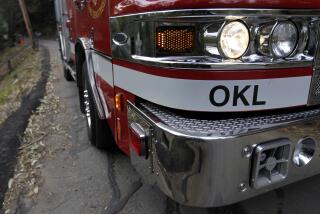The Fight Against Crime: Notes From The Front : Record Speaks for Itself With ‘Jaws of Life’
- Share via
Lt. Gary Lynch, commanding officer of the LAPD’s Valley traffic division, remembers the scene well.
It was about 11 years ago when a 300-pound woman rammed her compact Toyota Tercel into a telephone pole in Van Nuys near the intersection of Van Nuys Boulevard and Vanowen Street. The large woman was stuck in her car as it crushed around her.
Police were stuck too, until the Fire Department arrived with the “Jaws of Life.” Firefighters quickly pried the woman out, quite possibly saving her life, but surely saving police hours of struggle. Since the late 1970s when the Hurst Tool Co. first started making the “Jaws of Life,” both police officers and firefighters say the tool has saved thousands of lives.
“The Jaws of Life were the biggest advance as far as rescue when they came out,” said James Young, chief of Fire Station 88 in Sherman Oaks.
The “jaws” help rescuers reach through car windows and rip out steering wheels pressed up against passenger’s chests, tear off jammed doors or pry apart accordioned bodywork.
Although the California Highway Patrol is in charge of all freeway traffic accidents, it’s the firefighters who have to get the victims out.
“By law it’s our job to make sure the scene is secure so that the Fire Department can get in to help the victims,” said Bruce Ferrier, an officer in the CHP’s Transportation Management Center.
If the victim is not stuck too far in the car and there is no possibility that they will be further injured, CHP officers may try to pull them out. If not, firefighters bring in the jaws.
The jaws are powered by a gasoline engine housed in a cylinder about the size of a five-gallon drum attached to a firetruck. Hydraulically activated levers extending from the drum can be pushed into the car and then forcefully spread apart up to 32 inches, acting as a “tiny wedge that has tremendous hydraulic power,” Lynch said.
The jaws’ arms can grasp and lift up to 18,600 pounds.
Over the past 15 years or so, the jaws have become lighter and more user-friendly, said Firefighter Rodolfo Santiago, who operates one. Usually one firefighter works the machinery while another guides the arms.
Although the tool itself has not changed much since it was invented in the late 1970s, the technique of using it grew more sophisticated with the lessons learned by operators who used it to rescue victims of Hurricane Andrew in Florida in 1992.
The improved techniques helped the Fire Department use the jaws on wrecks in ditches, embankments and other areas previously considered unreachable.
How did the jaws get their well-known name?
“The reason they call it the Jaws of Life is because the arms of the machine pinch together like a mouth,” Young said.
Lynch said the jaws are particularly important to Californians because many use their cars almost every day, increasing the likelihood they will be involved in an accident.
Santiago and Young said the San Fernando Valley, with its wide streets and long spaces between stoplights, is especially likely to be the scene of high-speed accidents in which vehicles will be crushed around the occupants.
The success rate of the jaws is incomparable, Lynch said.
“Not once have I seen it not work,” he said.
More to Read
Sign up for Essential California
The most important California stories and recommendations in your inbox every morning.
You may occasionally receive promotional content from the Los Angeles Times.








